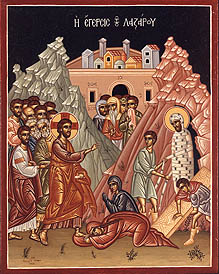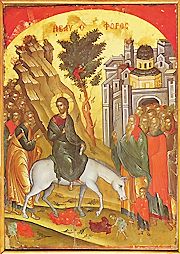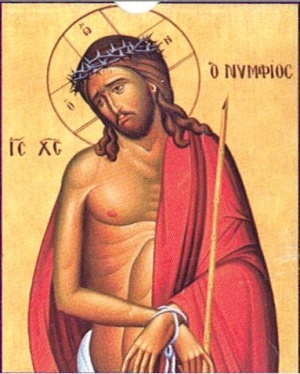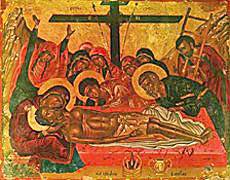How Many Hours Of Services Orthodox Holy Week

A worshiper prostrates earlier the cross at the Twelve Passion Gospels service at St. Mary Orthodox Church in Cambridge, Massachusetts.
Great and Holy Calendar week is the week from the conclusion of Not bad Lent on the Sat of Lazarus to the celebration of Pascha. It is emphasized that the services of Holy Week follow the ecclesiastical solar day, that is from sundown to sundown. Thus Sat of Lazarus ends at sundown on Sat.
Contents
- one History
- 2 The Holy Week
- 2.1 Palm Sunday
- 2.2 Holy Monday
- two.3 Holy Wednesday
- 2.4 Holy Thursday
- 2.5 Holy Friday
- two.vi Holy Saturday
- 3 Pascha
- 4 Local community
- iv.1 Jerusalem
- four.2 Greece
- 5 External links
History
While trivial is recorded of the development of the celebrations of the Holy Week during the early on years of the Church building, it manifestly had very early origins. By the quaternary century the celebration of the calendar week appears well-founded and to be similar to our celebrations today. The pilgrim Egeria to Jerusalem in the latter part of the fourth century described the events of the calendar week subsequently the services of the Saturday of Lazarus, "...began the calendar week of the Pasch, which they chosen hither the Neat Week", noting the procession commemorating Christ's triumphal entry into Jerusalem on the first day of the week. Information technology is during this calendar week that we remember Christ's Passion and Crucifixion.

The Raising of Lazarus
The Holy Week
Lazarus Saturday concludes Not bad Lent. This celebration remembers Christ's raising of Lazarus from the dead and the promise of universal resurrection for all. Lazarus Saturday provides a span to Holy Week during which the Church services remember Christ's last week before his crucifixion and resurrection, his passion. During this calendar week the Matins services for the upcoming solar day are celebrated the evening before, and Vespers is historic in the morning. This anticipation of the Church building'south services gives the faithful a sense that the earth is in travail, upside-down, because of the passion our Lord endured for our conservancy. Although this practice is unusual, it is approved in accordance with the ancient definition that the solar day is from dusk to sunset.

Icon of Christ'south entry into Jerusalem

Palm Lord's day
The first mean solar day of Holy Calendar week begins with Vespers of Saturday evening leading to the celebration of the services of Our Lord's Entry into Jerusalem the next morning, Sunday. In the western world this day is usually called Palm Sunday. As Christ makes his triumphal entry into Jerusalem, his divine kingdom on Earth is proclaimed under the branches of the palm tree.
Holy Monday
The first 3 days of Holy Week remind united states of america of Christ's last instructions with his disciples. These teachings are remembered in the commemoration of the Neat Compline, Matins, Hours, and Liturgy during these days. The Liturgy of the Presanctified Gifts historic these days includes readings from Exodus, Task, and Matthew.
The Matins services of the evenings of Palm Sunday, Holy Monday, and Holy Tuesday, anticipating the events of the next twenty-four hour period, share a common theme. These Bridegroom Services are derived from the Parable of the Ten Virgins, which calls for preparedness at the Second Coming, for the "thief comes in the eye of the night." (Matt. 26:1-13)
Holy Wednesday
Within the by two centuries, Byzantine practice has developed to include the mystery of Holy Unction, which is celebrated on Holy Wednesday, commemorating Christ's anointing with myrrh. The service ends with the priest anointing the faithful with holy oil. Some jurisdictions outside the Byzantine world also include this practice, such equally in some parts of the OCA.
The services appointed past the Typikon for the evening of Holy Wednesday recall that on this 24-hour interval Judas betrayed Christ, which led to the tradition from Apostolic times of fasting on Wednesday throughout the year. Information technology also focuses on the Mystical Supper, which is historic in the liturgy of the following mean solar day.

Holy Thursday
Holy Th begins with the celebration of vespers and the Divine Liturgy of St. Basil, in representation of the earthly presence of Christ realized at the Last Supper. In the evening, anticipating the Matins of Friday morning, the Holy Passion service of the reading of the Twelve Gospels is conducted. In these readings Christ's terminal instructions to his disciples are presented, as well as the prophecy of the drama of the Cross, Christ's prayer, and his new commandment. The twelve readings are:
- John thirteen:31-18:i
- John 18:one-29
- Matthew 26:57-75
- John 18:28–xix:sixteen
- Matthew 27:3-32
- Mark 15:xvi-32
- Matthew 27:33-54
- Luke 23:32-49
- John xix:19-37
- Mark 15:43-47
- John 19:38-42
- Matthew 27:62-66

Holy Friday
Great and Holy Friday begins with reading of the Royal Hours leading up to Vespers of Fri afternoon, at which fourth dimension the removal of the Trunk of Christ from the Cross is commemorated. The priest removes the Trunk of Christ, the Epitaphios, from the Cantankerous, wraps it in a white textile and carries it into the chantry. In an evening service, called the Lamentations at the Tomb, the priest carries the Epitaphios, the painted or embroidered fabric representation of Christ, from the chantry around the church before placing it in the Sepulcher, a bier symbolizing the Tomb of Christ. This procession, with the faithful carrying lighted candles, represents Christ's descent into Hades.

Epitaphios
Holy Saturday
Peachy and Holy Saturday Vespers and a Divine Liturgy of St. Basil are served, marked with readings of Psalms and Resurrection hymns that tell of Christ's descent into Hades, celebrated every bit the "Starting time Resurrection" of Adam and the acquisition of Death. It is appointed past the typikon to exist historic in the afternoon, though it is served in the morning in many places.
This service comes from the ancient liturgical tradition of the Church of Constantinople and was its primary Paschal service. The hymn "Arise O God" from the Psalms was the original primary Paschal hymn before "Christ is risen" came to take its place. Its place as the aboriginal Constantinopolitan Paschal commemoration is what gives the service such a vivid and resurrectional character.
Pascha

The Resurrection of Christ
- Main article: Pascha
Pascha, the Feast of Feasts, celebrations begins just before midnight with the singing of the Odes of Lamentation as the Resurrection Vespers begins with the church in complete darkness. Equally midnight approaches the priest taking a light from a vigil calorie-free within the altar passes the flame to the faithful for their candles while singing "Come up ye and receive low-cal from the unwaning life, and, glorify Christ, who arose from the dead." Then the priest leads the faithful out of the church in procession. Subsequently circumvoluted the church either 1 or iii times, equally the procession nears the entrance door of the church, the priest leads in the singing of the hymn of Resurrection. "Christ has risen from the dead, by death trampling upon Decease, and has bestowed life upon those in the tombs!" At this point the priest and faithful enter the well-lighted church building for the remaining part of Vespers and the breaking of the fast with the Divine Liturgy. After conclusion of the Divine Liturgy, in many communities, the faithful retire to an afraid meal to break the Fast together, and then return home equally dawn arrives. Later in the twenty-four hour period of Pascha the true-blue again get together for prayer with lighted candles in a vespers service, singing the hymn "Christ is Risen from the Expressionless," and greeting each other joyously, "Christ is risen" and responding with, "Truly He is risen."
Local customs
Jerusalem
- The Orthodox Patriarch breaks the seal of the door of the tomb of Christ in the Church building of the Holy Sepulchre and emerges with the Holy Fire.
Hellenic republic
- Painting of the blood-red eggs
- Preparation of sweets ("Koulouria")
- The Holy Burn is flown from Jerusalem on Olympic Airways, accompanied by high-ranking Greek Orthodox priests and government officials to the Athens airport. The Holy Flame is met with a reception of honour guards and is taken to the small church of Agioi Anargyroi in the Plaka square.
- On Sunday, all over Greece, the Greek people will agree very festive celebrations. Traditionally, lambs are roasted (which symbolise Christ), and friends and family unit become together to eat, drink, talk and dance.
In some towns, this tradition is a community celebration. For example:
-
- In Arachova, rows of lambs are roasted in the village foursquare.
- On some islands, the town shoots "Judas"
External links
- A Liturgical Explanation for the Days of Holy Week, by Fr. Alexander Schmemann
- The Historical Development of Holy Week Services In the Orthodox/Byzantine Rite, by Fr. Nabil L. Hanna
- Holy Week GOARCH
- The Origins of Pascha and Great Calendar week - Office I
- The Origins of Pascha and Groovy Calendar week - Part II
- Holy Calendar week and Pascha
- Holy Week
- Approach to Holy Week
How Many Hours Of Services Orthodox Holy Week,
Source: https://orthodoxwiki.org/Holy_Week
Posted by: williamsvanctiod.blogspot.com


0 Response to "How Many Hours Of Services Orthodox Holy Week"
Post a Comment